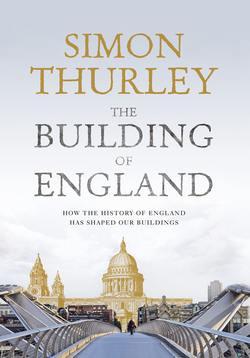The Building of England: How the History of England Has Shaped Our Buildings

Реклама. ООО «ЛитРес», ИНН: 7719571260.
Оглавление
Simon Thurley. The Building of England: How the History of England Has Shaped Our Buildings
Contents
Building in England 410–1930
The Problem of English Architecture
Some Big Ideas
How English Buildings Looked
The End of Rome
How the Saxons Built
Where People Lived
The Church before the Vikings
The Mercian Kingdom
The Anglo-Saxon Church
Monasteries
Bishops and Kings
The Rise of Local Churches
Building Techniques and Materials
Great Churches: The First Phase
The Parishes
The Towns
The Establishment of Castles
Building Materials and Technology
The Normans and the English
Old Principles, New Fashions
Monasteries
Where the Rich and Powerful Lived
Getting About
The Countryside
Towns
Introduction
Beliefs and Ideas
Landscapes of Power
How People Worshipped
Defence of the Realm
A Capital City
Introduction
A Century of Crisis 1300–1408
Effects on Building
The Language of Architecture 1320–1400
Aristocratic Houses: the Wartime Generation 1350–1400
The Parishes 1380–1530
Civic Pride 1350–1450
Trade and Commerce 1350–1530
Lancaster and York 1422–1485
Aristocratic Houses: The Second Generation 1470–1520
The Coming of the Tudors 1485–1530
Building Materials
Suppression and Iconoclasm
Influences from Abroad
Royal Palaces, Forts and Dockyards
Urban Building
Houses of the Nouveau Very Riche
Houses for Everyone Else
Keeping Clean and Warm
Architecture for Learning
Patrons, Architects and Contractors
Churches from Elizabeth to the Civil War
Introduction
Civil War
Polite Taste
London
Palaces for the Sick, Injured and Mad
Royal and Aristocratic Palaces
The Army and Navy
Introduction
Polite Taste
Religious Building
Public Buildings in London
Government, Justice and Commerce in Provincial Towns
Aristocratic Life in Town and Country
Living in the Country
Introduction
Building Styles
Sailing the Seven Seas
Inland transport
The Struggle Against France
Manufacturing Buildings
Going to Church
Town Building
Polite Town Houses
Aristocratic Houses in Town and Country
Public Buildings
Icons of England’s Olden Time
Technology, Materials and Methods
Railway Revolutions
Stylistic Developments
Churches
Country Estates
Living in Towns
Commercial Buildings
Drinking Responsibly
Municipal Buildings
Crime and Punishment
The Poorer in Sickness and in Health
Technological Advances
The Languages of Polite Architecture
The Hub of Empire
Housing the Multitude
The First World War
Industry and the First World War
Housing after the First World War
Getting About
Education
The Commercialisation of Leisure
Communications
Shopping
Last Words
Endnotes
Picture credits
Index
Acknowledgements
Отрывок из книги
Cover
Title Page
.....
On a number of occasions new architectural languages were imported in a measured form that was then embellished and decorated. This reflects an underlying preference for ornamentation. The severity of Norman Winchester Cathedral (fig. 44), for instance, soon gives way to the exuberance of the nave at Durham Cathedral (fig. 51), something, perhaps, more florid and native, while the introduction of austere classical forms at Longleat House, Wiltshire (p. 212), turns into the encrustations of a house like Wollaton Hall, Nottinghamshire (fig. 195).
So there is a pendulum of taste swinging from austerity, simplicity and minimalism to ornament, colour and exuberance, and then back again. The Norman Conquest swept away the decorated buildings of the late Saxons, generating an architecture of military sobriety; but this gave way, in reaction, to the exuberant buildings of the 12th century. The way the English used Gothic from the 1170s was very austere, but this led to its elaboration and decoration from the 1250s. Simplicity of line and cleanness of form began to return in the 1340s, remaining the accepted language until the 1450s, when it became decorated and exuberant again. Towards the end of the reign of Henry VII and lasting until around 1530, simplicity and austerity returned before being overwhelmed by the theatre of Henry VIII’s court architecture. Then there was a short period of austere classical rigour from the 1550s to the 60s before a riot of Elizabethan and Jacobean decoration commenced. By the 1630s the mood swung back to minimalism, which remained to the Restoration until the richness and inventiveness of Wren, Hawksmoor and Vanbrugh become fashionable. Under the influence of Lord Burlington and his approved architects a more tempered and austere classical architecture then took over until the 1760s, when there was an explosion of decorative styles. The simplicity of the Grecian revival in the 1820s was transformed into the richness and colour of revived Renaissance styles in the 1830s. The purity of Gothic Revivalism in the 1840s then led to a riot of expressiveness of High Victorian Gothic in the 1860s, before a return to the simplification of forms of so-called ‘Queen Anne’ from the 1870s. This, in turn, gave way to a revival of interest in baroque forms, which itself stimulated a new breed of minimalist modern classicism.
.....